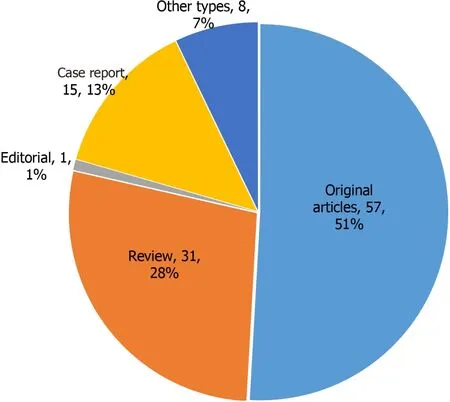New Year’s greeting and overview of World Journal of Hepatology in 2021
Ke-Qin Hu, Koo Jeong Kang, Nikolaos Pyrsopoulos, Xiang Li
Ke-Qin Hu, Division of Gastroenterology and Hepatology, University of California, Irvine Medical Center, Orange, CA 92868, United States
Koo Jeong Kang, Division of Hepatobiliary Pancreatic Surgery, Department of Surgery, Keimyung University Dong-San Medical Center, Daegu 41931, South Korea
Nikolaos Pyrsopoulos, Medicine-Gastroenterology and Hepatology, Rutgers-New Jersey Medical School, Newark, NJ 07103, United States
Xiang Li, Production Department, Baishideng Publishing Group Inc, Pleasanton, CA 94566, United States
Abstract The World Journal of Hepatology (WJH) was launched in October 2009.It mainly publishes articles reporting research findings in the field of hepatology, covering a wide range of topics, including viral hepatitis B and C, non-alcoholic fatty liver disease, alcoholic liver disease, autoimmune and chronic cholestatic liver disease, drug-induced liver injury, cirrhosis, liver failure, hepatocellular carcinoma, coronavirus disease 2019-related liver conditions, etc.As of December 31, 2020, the WJH has published 1349 articles, among which, the total cites is 18995 and the average cites per article is 14.In celebrating the New Year, we are pleased to share with you special a New Year’s greeting from the WJH Editors-in-Chief, along with a detailed overview of the journal’s submission, peer review and publishing metrics from 2020.In all, we are appreciative for the substantive support and submissions from authors worldwide, and the dedicated efforts and expertise provided by our invited reviewers and editorial board members.
Key Words: World Journal of Hepatology; New Year’s greeting message; Editors-in-Chief; Editorial Board; Highly influential scientists; Baishideng Publishing Group Inc
INTRODUCTION
TheWorld Journal of Hepatology(WJH, ISSN 1948-5182, https://www.wjgnet.com/1948-5182/index.htm) is a high-quality, monthly, online, open-access, single-blind peer-reviewed journal published by the Baishideng Publishing Group Inc (BPG).The primary aim ofWJHis to provide scholars and readers from various fields of hepatology with a platform to publish high-quality basic and clinical research articles and communicate their research findings online.TheWJHis abstracted and indexed in PubMed, PubMed Central, Emerging Sources Citation Index (Web of Science), and Scopus.
Since its launch in October 2009, theWJHhas published 1349 articles[1].As of December 31, 2020, the total cites among these articles is 18995 and the average cites per article is 14.
A NEW YEAR’S GREETING FROM THE WJH EDITORS-IN-CHIEF
For all of us, 2020 was a very tough year due to coronavirus disease 2019 (COVID-19).As Editors-in-Chief ofWJH, it is now our great pleasure to take this opportunity to wish all our authors, readers, Editorial Board members, independent expert referees, and staff of the Editorial Office a very Happy New Year.On behalf of the Editorial team, we would like to express our gratitude to all authors who contributed their valuable manuscripts, as well as all independent referees and readers for their continuous support, dedication, and encouragement.Together with an excellent team effort by our Editorial Board members and staff of the Editorial Office and BPG,WJHwas able to advance in 2020 despite the ongoing COVID-19 pandemic.
As the chief editors, we strive to work with the journal’s Editorial Office and BPG staff to make the manuscript submission process as simple as possible and ensure an efficient communication with the authors to provide our support and answer their questions.We are also open to any suggestions that could improveWJH’s operation and publication.Please feel free to contact us at (editorialoffice@wjgnet.com) with any question on your submission or suggestions for the journal in general.
OVERVIEW OF THE WJH IN 2020
In celebratingWJH’s 12-year anniversary and the 2021 New Year, we are very proud to share with you that we completed the following endeavors in submission, peer review and publishing in 2020.
Submission and acceptance
From 2013 to 2020, theWJHhas received 2302 manuscripts, including invited manuscripts and unsolicited manuscripts, and the average submissions per year is 288.The submissions of unsolicited manuscripts are stable in recent years (Figure 1).

Figure 1 Annual submissions of World Journal of Hepatology from 2013 to 2020.
In 2020, we received 204 submissions from authors around the world and published 112 articles in 12 issues.Among those 112 articles, 57 (50.9%) were original articles, 31 (27.7%) were review articles, 1 was an editorial (0.9%), 15 (13.4%) were case reports and 8 (7.1%) were articles of ‘other’ types (Figure 2).The authors hailed from 32 countries, including 32 (28.6%) from the United States, 10 (8.9%) from Brazil, 6 (5.4%) each from Italy, Japan and Spain, and 5 (4.5%) each from the United Kingdom and France; the remaining 26 (23.2%) were from various individual countries (Figure 3).
Invitation for 2021
In November and December, invitations to contribute high-quality articles toWJHwere sent out to distinguished scientists in the field of hepatology.As of December 31, 2020,WJHhas accepted a total of 327 proposed titles for those invited manuscripts; these articles, to be submitted for publication in 2021, include 85 (26.0%) original articles, 215 (65.7%) review articles, 15 (4.6%) editorials, and 12 (3.7%) ‘other’ types (Figure 4).We are currently inviting highly influential scientists to submit Topic Highlight articles, commenting on and discussing hot topics in the field of hepatology.As of December 31, 2020, we have already received 14 submissions online.
Conducting peer review statistics
As of December 31, 2020,WJHhad sent out 6120 invitations to peer reviewers and Editorial Board members to conduct peer review of manuscripts.Among the peer reviewers and Editorial Board members who accepted the invitation, 428 (35.0%) submitted the peer review report on time, 425 (34.7%) failed to submit the peer review report on time, and 370 (30.3%) have not submitted the peer review report yet.
Editorial Board members of WJH
The 2020 Editorial Board ofWJHwas composed of 195 members[2].Among them, 3 were Editors-in-Chief (Professor Ke-Qin Hu, Professor Koo Jeong Kang, and Professor Nikolaos Pyrsopoulos), 5 were Associate Editors, and 187 were Editorial Board Members.The members were based in 45 countries and areas, including 23 (11.8%) in China, 22 (11.3%) in Italy, 19 (9.7%) in the United States, 18 (9.2%) in Turkey, 11 (5.6%) in Egypt, and 102 (52.3%) in various other countries (Figure 5).A total of 86 (44.1%) of the Editorial Board Members served as peer reviewers in 2020.
We are pleased to have received 71 applications for Editorial Board membership (up to December 2020), which are currently under evaluation.
Journal metrics
According to data from the Web of Science (up to January 4, 2021),WJHpublished 258 articles between 2017 and 2018.These articles were cited 830 times in 2019, with a mean citation of 3.217 for each.On behalf ofWJH, BPG will submit an application to Clarivate Analytics for abstracting and indexing in Science Citation Index Expanded (SCIE), in the near future.WJH’s Scopus CiteScore for 2019 is 5.8, ranking 22/61 in the category of Hepatology.

Figure 2 Article types among the 112 manuscripts published by World Journal of Hepatology in 2020.

Figure 3 Top 16 countries by number of World Journal of Hepatology published manuscripts in 2020.
Accurately pushing WJH articles and authors ahead
To enable more peers to read, share, and citeWJHauthors’ published research results and to help enhance their global academic influence and reputations, thereby also promoting the overall development of the field of hepatology, BPG sendsWJH’s published articles to 1000-10000 highly influential experts in a topically-accurate manner.After completing this outreach activity, BPG formally notifies the paper’s authors of the number of experts to whom their manuscript was sentviaemail.As of December 31, 2020,WJHarticles included in the push email campaign were sent to 19905 in October, 5308 in November, and 11023 in December.
Challenges facing WJH in 2021
The development and growth ofWJHrely on a large amount of high-quality manuscripts.We appreciate and encourage all authors to submit their topicallyrelevant manuscripts toWJH, to enjoy the benefits of this great platform and sharing resource in disseminating their medical research results.Our Editorial Board members are encouraged to continue their support by actively serving as peer reviewers, authors contributing articles, and journal representatives inviting high-quality articles from others.WJHEditorial Board members are also encouraged to communicate with the Editors-in-Chief actively, provide suggestions and analyze discipline hotspots to promote their academic influence through theWJH.

Figure 4 Article types of World Journal of Hepatology invited manuscripts for 2021.

Figure 5 Countries of World Journal of Hepatology Editorial Board Members in 2020.
CONCLUSION
In 2021,WJHwill publish more high-quality original and review articles, consistently improving its academic influence and moving closer towards its next goal of inclusion in the SCIE as soon as possible, which will ultimately promote the overall development of the field of hepatology.WJH’s Editors-in-Chief and Editorial Office staff expect to be more productive and have committed to working diligently with all of you to raise the academic rank ofWJHin 2021.In order to achieve these goals, we recognize the importance of substantive support and submissions from authors like you in tandem with the dedicated efforts and expertise of our invited reviewers, many of whom also serve on our Editorial Board.Please feel free to contact our Editorial Office (editorialoffice@wjgnet.com) if you have further questions, need support, or wish to share your suggestions.
 World Journal of Hepatology2021年1期
World Journal of Hepatology2021年1期
- World Journal of Hepatology的其它文章
- Autophagy in liver diseases
- Post-liver transplant biliary complications: Current knowledge and therapeutic advances
- Shifting perspectives – interplay between non-alcoholic fatty liver disease and insulin resistance in lean individuals
- Integrative analysis of layers of data in hepatocellular carcinoma reveals pathway dependencies
- Association of interferon lambda-4 rs12979860 polymorphism with hepatocellular carcinoma in patients with chronic hepatitis C infection
- Immunization status and hospitalization for vaccine-preventable and non-vaccine-preventable infections in liver-transplanted children
